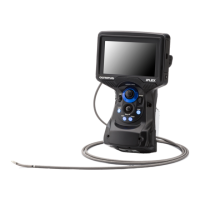106
Chapter 4 Operation
EVIS LUCERA GIF/CF/PCF TYPE 260 Series OPERATION MANUAL
• The application of high-frequency current may interfere with
the endoscopic image. This does not indicate a malfunction.
• When the endoscope is used with the electrosurgical unit
ESG-100, it is not necessary to use the S-cord.
Laser cauterization treatment (except GIF-N260, GIF-XP260)
• Performing treatment while the intestines are filled with a
flammable gas could result in an explosion, fire and/or
serious patient injury. If the intestines contain a flammable
gas, replace it with air or a nonflammable gas such as CO
2
before performing laser cauterization treatment.
• To avoid patient injury, burns, bleeding, and/or perforation as
well as damage to the endoscope, do not activate laser
radiation before confirming that the tip of the laser probe
appears in the proper position in the endoscopic image. Keep
an appropriate distance between the target and the
endoscope’s distal end, and always use the lowest power
output possible.
• Always wear protective eyewear when performing laser
cauterization. Otherwise, operator injury may occur.
• Before inserting or withdrawing the laser probe, return the
UP/DOWN and RIGHT/LEFT angulation control knobs to
their neutral positions (see Figure 3.7 on page 67) so that the
bending section will be straight. If it is bent, the instrument
channel and/or the laser probe may be damaged.
• Do not use a damaged laser probe. A laser probe with a
damaged sheath or distal end may cause patient injury
and/or equipment damage.
Prepare, inspect, and connect the laser unit and laser probe as described in their
instruction manuals.

